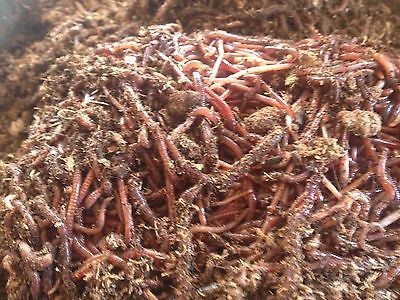Composting-perfect red wigglers: Learn to harvest castings
Composting-perfect red wigglers: Learn to harvest castings
Blog Article
Everything You Required to Understand About Red Wigglers for Composting
Red wigglers, or Eisenia fetida, play a pivotal duty in the realm of composting, changing organic waste into valuable soil modifications. The procedure of establishing up a worm container and keeping it can pose challenges.
What Are Red Wigglers?

(Western North Carolina Bait)
Native to North America, red wigglers are surface-dwelling organisms that favor moist, cozy environments abundant in disintegrating raw material. Their diet plan consists mostly of decomposing plant material, food scraps, and other natural particles, which they take in and break down efficiently. As they absorb this product, they create nutrient-rich spreadings that enhance dirt fertility.
Red wigglers are hermaphroditic, having both male and women reproductive organs, and can duplicate swiftly under optimal problems. On the whole, red wigglers are essential factors to the procedure of reusing organic waste right into valuable garden compost.
Advantages of Utilizing Red Wigglers
Utilizing red wigglers in composting systems offers numerous advantages that boost both the efficiency of waste management and the quality of the resulting garden compost. These worms, clinically called Eisenia fetida, are especially effective at breaking down raw material, turning kitchen scraps and yard waste right into nutrient-rich compost at a sped up price.
Among the key benefits of utilizing red wigglers is their capacity to take in large amounts of organic product, usually processing their weight in food waste daily. This high intake rate leads to quicker disintegration and lowers the quantity of waste sent out to garbage dumps. Additionally, the castings generated by red wigglers are abundant in vital nutrients, advantageous bacteria, and enzymes, making them an exceptional fertilizer for gardens and plants.
In addition, red wigglers flourish in a range of settings, making them versatile for both interior and exterior composting systems - red wigglers. Their visibility in a garden compost container helps to freshen the material, preventing smells and advertising a healthy composting procedure. Overall, using red wigglers not only adds to reliable waste monitoring however additionally sustains sustainable gardening practices with the manufacturing of top quality compost
(Lake James Bait)
Setting Up Your Worm Container
To efficiently set up a worm bin, it is necessary to select a proper container that satisfies the requirements of red wigglers while supplying a favorable setting for composting. An ideal container can be made from plastic, timber, or metal, with a capability of at the very least 1 square foot for every single pound of worms.
Ensure the container has ample drain openings to stop excess moisture, as red wigglers thrive in a damp, however not waterlogged, atmosphere. red wigglers. The bin must additionally be ventilated to offer adequate air flow, protecting against anaerobic conditions that could harm the worms
A suitable place for the worm container is a cool, dark area, without direct sunshine and extreme temperature levels, as red wigglers favor a temperature array of 55 to 77 levels Fahrenheit.
Before introducing the worms, prepare bedding products such as shredded newspaper, cardboard, or coconut coir, which will certainly provide both habitat and food. Dampen the bedding lightly to create an inviting setting for the worms. Think about placing a lid on the container Web Site to keep humidity and reduce insects, while ensuring it can be quickly gotten rid of for upkeep.
Feeding and Treatment Guidelines
Feeding red wigglers is an important aspect of maintaining a healthy composting system. These worms grow on a diverse diet, primarily composed of natural products such as fruit and vegetable scraps, coffee premises, and smashed eggshells. It is vital to stay clear of feeding them meat, dairy, and oily foods, as these can create undesirable odors and attract insects.
When introducing food to your worm container, slice or shred products into smaller sized items to facilitate quicker disintegration. Beginning with tiny quantities to assess the worms' consumption rate, gradually enhancing the amount as they adjust. It is recommended to alternative feeding places within the container to encourage detailed blending and aeration of the garden compost.

Troubleshooting Common Issues
Preserving a thriving worm composting system can often present obstacles that need attention and troubleshooting. Common concerns consist of an undesirable odor, which usually indicates overfeeding or the existence of anaerobic problems. To remedy this, minimize the amount of food included and ensure appropriate oygenation by mixing the bed linen product.
One more frequent problem is the retreat of worms from the container. This can happen because of extreme wetness or unsuitable ecological conditions. Frequently check the moisture levels, aiming for a moist yet not soggy consistency, and keep optimal temperatures in between 60-80 ° F(15-27 ° C )to produce a comfortable habitat for your red wigglers.
Pests, such as fruit flies, can also invade worm containers. red wigglers. To battle this, cover food scraps with a layer of bed linen or shredded paper to deter flies from laying eggs. Furthermore, guarantee that any kind of food added is fresh and without mold, which can draw in undesirable pests
Last but not least, if your worms seem non-active, look for stress aspects such as temperature level variations or insufficient moisture. Resolving these typical concerns will certainly help preserve a healthy and productive worm composting system.
Final Thought
In recap, red wigglers, or Eisenia fetida, play a vital duty in lasting waste monitoring with vermicomposting. Correct setup and upkeep of a worm container, along with adherence to feeding standards, make sure a thriving ecological community that reduces garbage dump payments.
Report this page